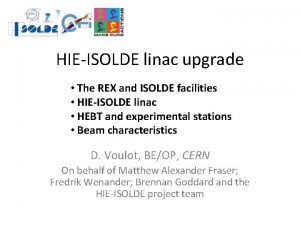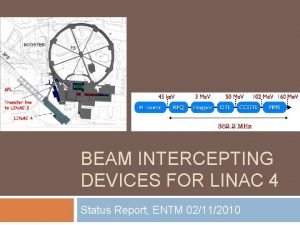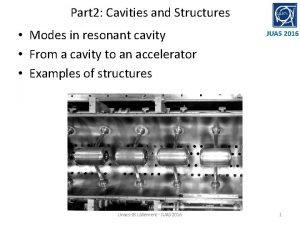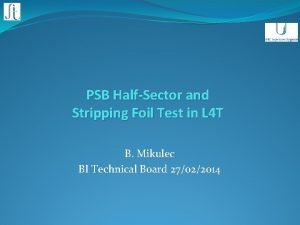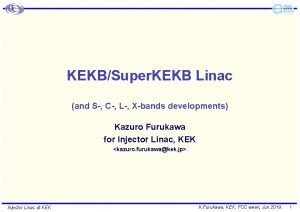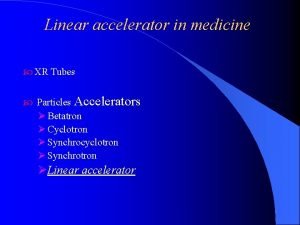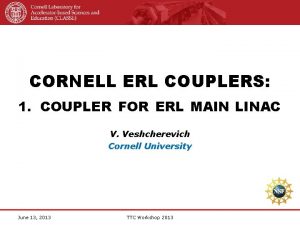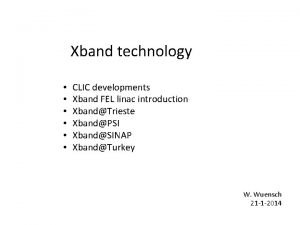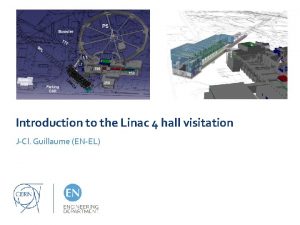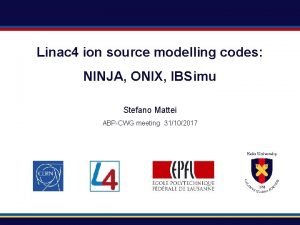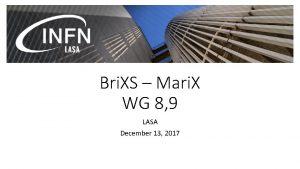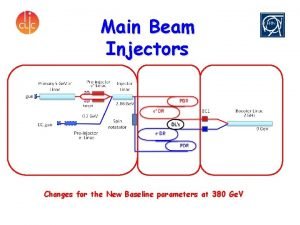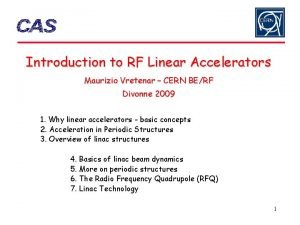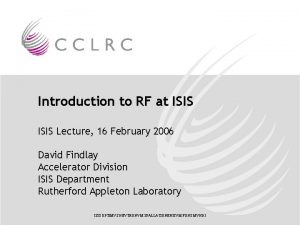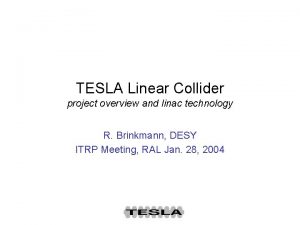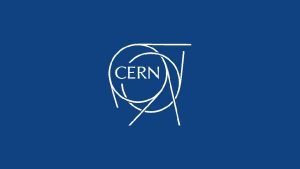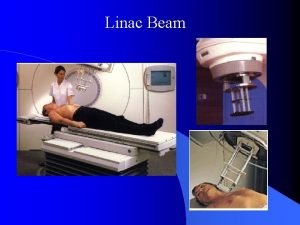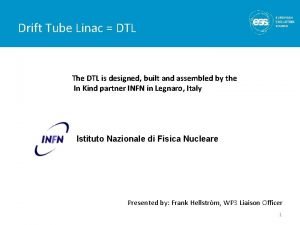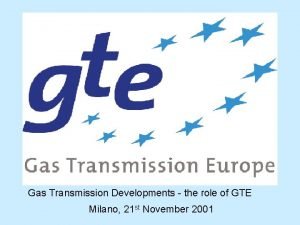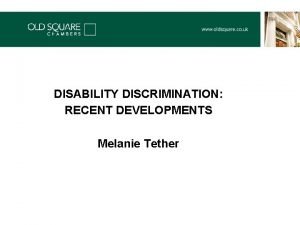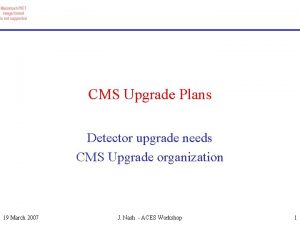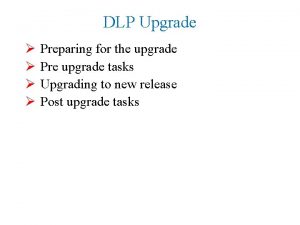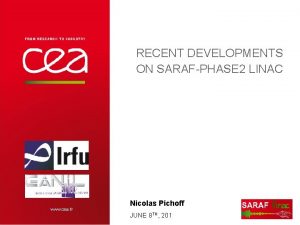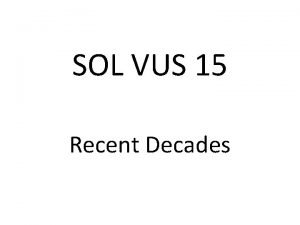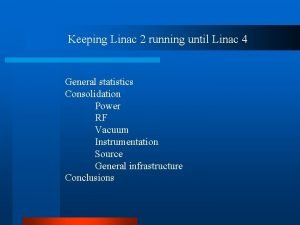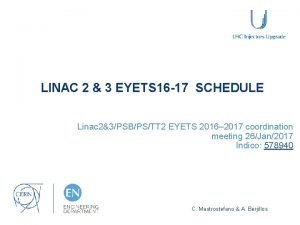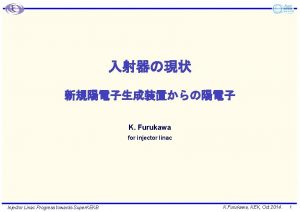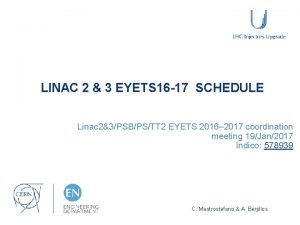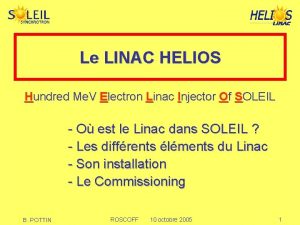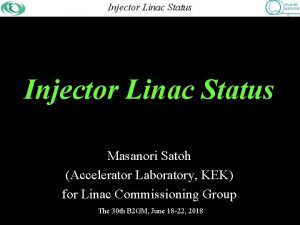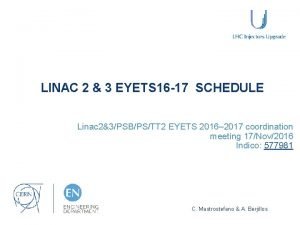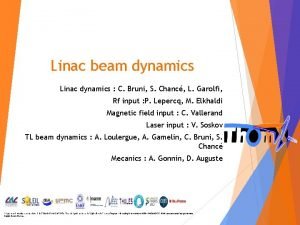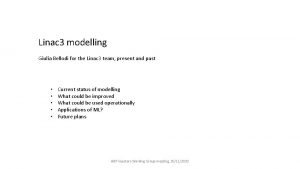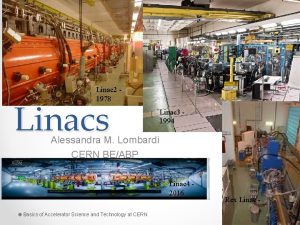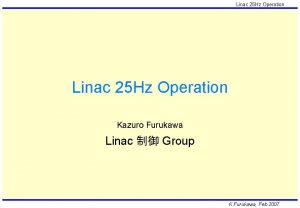Recent Linac developments for the upgrade of the
























- Slides: 24

Recent Linac developments for the upgrade of the CERN proton complex + Front-end studies at RAL & CERN Maurizio Vretenar, CERN AB/RF Overview: Ø Status and plans for the CERN Proton Accelerators Ø Linac projects at CERN: from SPL to Linac 4 Ø Linac 4 overview and schedule Ø Front-End Test Stand at RAL and 3 Me. V Test Stand at CERN 1 MV BENE 15. 11. 2006

The CERN Accelerator Complex The LHC Injection chain: Linac 2 (50 Me. V) PS Booster (1. 4 Ge. V) PS (25 Ge. V) SPS (450 Ge. V) LHC Luminosity proportional to the brightness (Nb/e) from the injectors. Concerns: 1. Reliability (PS 58 years, …) 2. Brightness (can provide nominal luminosity but not ultimate) 2 MV BENE 15. 11. 2006

Physics Guidelines for the evolution of the CERN proton complex (POFPA) 1. LHC n “Maximize the integrated luminosity” Þ Þ Þ n 2. “Study the possibility of a higher energy LHC” Neutrino physics n Until the physics case is clear (~ 2010 -2012) Þ Þ n Pursue development for {b-beam + super-beam} and n factory Depending on physics and outcome of technical developments, elaborate a proposal for a n facility at CERN After ~2010 Þ 3. Minimize turn-around time by improving reliability / minimizing duration of stops Remove bottle-necks towards ultimate luminosity Refine / select scenario for SLHC (start in ~ 2015); progressive implementation Prepare for a n facility at CERN Other physics [physics with kaons, muons, heavy-ions (fixed-target), antiprotons and nuclear physics] l l Complement the accelerators resulting from the needs of priorities 1 & 2 Adapt experiments to the capabilities of the accelerators 3 MV BENE 15. 11. 2006

CERN Strategy and Priorities Strategy Group of CERN Council (European Strategy for Particle Physics, Lisbon, July 06): 1. 2. 3. 4. Fully exploit the physics potential of the LHC. Prepare (R&D) for an LHC luminosity upgrade towards 2015. Develop technology for next generation machines (CLIC, SC magnets, Nu. Fact) Participate to the design and preparation of ILC (assessment in 2010). Other European priorities: Neutrino Facilities (for 2012), collaborations on astroparticles, high int. low energy precision physics, facilities bw. particle and nuclear physics. Roadmap elaborated by the PAF = Proton Accelerators for the Future Working Group (R. Garoby et al. ): • LHC Improvement: achieve LHC ultimate + prepare LHC upgrades • Consolidation of the LHC Injection chain: concerns about reliability of PS& SPS magnets, etc. (slowly replace old injectors) • Leave open the option of a high-intensity facility 4 MV BENE 15. 11. 2006

The PAF Roadmap 5 MV BENE 15. 11. 2006

PAF Scenarios 6 MV BENE 15. 11. 2006

Linac 4 Overview 95 ke. V HRF volume source (DESY) 35 k. V Extrac. 60 k. V Postacc. 3 Me. V RFQ 3 Me. V CHOPPER Radio Frequency Quadrupole (IPHI) 352 MHz 6 m 1 Klystron 1 MW Chopper 352 MHz 3. 6 m 11 quads 3 cavities 40 Me. V DTL Drift Tube Linac 352 MHz 13. 4 m 3 tanks 5 klystrons 4 MW 82 PMQuad 90 Me. V 160 Me. V CCDTL SCL Cell-Coupled Drift Tube Linac 352 MHz 25. 3 m 24 tanks 8 klystrons 6. 5 MW 24 EMQuads Side Coupled Linac 704 MHz 28 m 20 tanks 4 klystrons 12 MW 20 EMQuads current: 40 m. A (avg. in pulse), 65 m. A (bunch) Duty cycle: 0. 1% phase 1 (PSB) 4% phase 2 (SPL) (design: 10%) Total Linac 4: 80 m, 18 klystrons 7 MV BENE 15. 11. 2006

Linac 4 parameters 2 operating modes: low duty for PS Booster (PSB) injection in the first phase, high duty for the SPL in a second phase. ØStructures and klystrons dimensioned for 50 Hz ØPower supplies and electronics dimensioned for 2 Hz. Will re-use LEP RF up to 90 Me. V energy: klystrons, waveguides and circulators. Linac 4 for PSB Linac 4 for SPL Maximum rep. frequency 2 50 Hz Source current 80 80 m. A RFQ current 70 70 m. A Chopper beam-on factor 62 62 % Linac pulse current 40 40 m. A 1. 46 m. A Average linac current 0. 032 Beam pulse length 0. 4 0. 73 ms Max. beam duty cycle 0. 08 3. 65 % 1 45 Transverse norm. emittance 0. 36 p mm mrad Longitudinal emittance 0. 19 p deg Me. V Max. N. of particles/pulse 8 1014 MV BENE 15. 11. 2006

Linac 4 collaborations INDIA: klystron power supplies CHINA: quadrupoles, bendings, buncher SCL IPHI = Injecteur de Protons Haute Intensite, French project building the RFQ for Linac 4 HIPPI = High Intensity Pulsed Proton Injectors, Joint Research Activity partially funded by the EU, contributing to the chopper line and to the design and testing of RF structures. ISTC = International Science and Technology Center, Russia, contributing to RF structure prototypes. Network of collaborations for the R&D phase, via EU-FP 6, ISTC, CERN-India and CERN/China agreements. The same network could support the construction of Linac 4 9 MV BENE 15. 11. 2006

Improvements to the CERN accelerator complex with Linac 4 1. Increase PSB brightness (for LHC) and intensity (for other users) by a factor 2: 160 Me. V factor 2 in bg 2 from 50 Me. V (DQ 1/bg 2) reach LHC ultimate luminosity, increase flux for ISOLDE 2. Fill PS in one PSB batch instead of 2 simplify operation, reduce LHC filling time. 3. Start the consolidation process of LHC injectors improve reliability, reduce losses in the PS complex 4. Open the way for future improvements: 5. LHC upgrades (luminosity and energy) 6. High-intensity (neutrinos, RIB) thanks to the dual operation (low duty for PSB, 10% duty possible for facilities mode of future 10 MV BENE 15. 11. 2006

SPL New Layout (CDR 2, 2006) LINAC 4 New SPL Design (CDR 2, CERN Yellow Report 2006 -006): 2 superconducting sections based on 5 -cell elliptical cavities at 704 MHz (TRASCO/CEA) Long cryomodules (LHC/TESLA-like, 12 -14 m), 6 -8 cav. /module, cold quads in cryomodules Overall length 430 m (for 3. 5 Ge. V, was 370 m in previous version for 2. 2 Ge. V) 11 Medium b High b Cavity b 0. 65 1 R/Q (Ohm) 235 575 Aperture (mm) 85 90 Ep/Eacc 2. 6 2. 4 Eacc (MV/m) 19 25 MV BENE 15. 11. 2006

CERN Linac Schedule & Strategy 12 MV BENE 15. 11. 2006

Linac 4 Schedule u u u 2006 (end) Linac 4 Technical Design Report December 2006 / beginning 2007: decision of construction 2007 Detailed design, definition of construction strategy, attribution of contracts 2008 -09 Construction (3 Me. V test place operational in 2008) 2010 End of installation and commissioning 2011 First physics run “Final” draft of Linac 4 Technical Design Report available on Linac 4 Web site: http: //project-spl. web. cern. ch/project-spl/linac 4. htm 13 MV BENE 15. 11. 2006

Linac 4 in the PS South Hall PS Booster TT 2 line PS ring Linac 2 Linac 3 Bldg 150 Linac 4 14 Bldg 152 MV BENE 15. 11. 2006

Linac, Shielding and Klystrons 15 MV BENE 15. 11. 2006

Why concentrate on Front-ends – Technology and Beam Dynamics The front-end contains some of the most challenging components of modern pulsed linac: The particle source (challenge of intensity, stability, reliability, …). The RFQ (construction, cooling, reliability, …). The chopper (rise time, pulse shape, losses, heating, …). In the linac simulations, emittance growth and beam loss are concentrated in the Front-end, which is the main source of halo (and everything will be worse with the real beam out of the source!) To limit the losses, halo and emittance growth at high energy need to study at the earliest stage the front end dynamics. 16 MV BENE 15. 11. 2006

RAL Front-End Test Stand (FETS) • Collaboration between CCLRC RAL, ASTe. C Intense Beams Group, Dept. Physics Imperial College London, Dept. Physics Warwick University • 3 Me. V, 60 m. A, H-, 50 Hz, 2 ms pulse length, 324 MHz, 2 ns chopping Density measurement (3 D) using laser wire: under construction High-brightness H- ion source 3 -solenoid Magnetic LEBT 3 Me. V beam Chopper and MEBT RFQ: 4 vane cold model under construction, 4 rod under study, 324 MHz klystron is delivered exact energy Measurement and beam dump 6 D phase space characterization: laser wire technique under study RFQ Chopper 17 MV BENE 15. 11. 2006

FETS – Ion Source and LEBT H— surface Penning ion source: ISIS: 35 m. A, 200 µs FETS: 60– 70 m. A, 1– 2 ms so far: 70 m. A, 250 µs extracted beam further improvements by: • extensive 3 D electromagnetic and thermodynamic modelling • separate penning field • geometry changes • experimental work on development rig 3 -solenoid LEBT: optimising the performance by: • increased solenoid field homogeneity by varying coil cross section, • tracking studies with measured source distribution. measured source distr. simulated LEBT output 18 MV BENE 15. 11. 2006

FETS – RFQ and chopper line RFQ — 3 Me. V, 324 MHz, l~4 m, 95% transmission, ~80 k. V electrode voltage 3 D model of 4 vane option Q~9000 Manufacture of cold model nearly finished alternative: 4 rod RFQ (under study) 2 -stage beam chopping with fast & slow chopper • fast pulser has achieved design specs: rise time <2 ns, droop <2. 5%, flat top: 15 ns, voltage: ± 1. 45 k. V • slow pulser (± 6 k. V) needs improvement on duty cycle, 19 • 3 beam dynamics schemes for the MV BENE 15. 11. 2006 MEBT are under study.

FETS - Beam diagnostics R&D Beam diagnostics based on photodetachment: 6 D emittance measurement device to use behind the RFQ under study Pepper pot emittance measurement device for the LEBT Laser wire beam tomography (LEBT) under construction (construction & pretests) 20 MV BENE 15. 11. 2006

The 3 Me. V Test Stand In construction - H- source (DESY type, - LEBT (2 solenoid) - The IPHI RFQ - Chopper line designed and built at CERN - Diagnostics line (IPHI and CERN components) - Infrastructure (1 LEP Klystron, pulsed power supply, etc. ) First beam foreseen in 2008. In the axis of Linac 4: the new 160 Me. V linac will be built in the prolongation of the test stand. 21 MV BENE 15. 11. 2006

The IPHI RFQ Side view of CERN-brazed module 2/6 modules brazed at CERN 4 modules in construction RFQ to be sent to CERN June 2008 Top view of CERN-brazed module 3 D drawing with accessories 22 MV BENE 15. 11. 2006

The 3 Me. V chopper line Compact design 3. 7 m length Dynamic range 20 – 60 m. A Small e growth 4% long. , 8% trans. Tolerant to alignment errors Dumping of chopped beam and collimation of unchopped beam in a conical dump structure 3 RF bunchers 23 Chopper structure: double meander strip line, 400 mm length, metallized ceramic plate. 2 ns rise/fall time for bunch selectivity (352 MHz beam structure), ± 500 V between deflecting plates. MV BENE 15. 11. 2006

3 Me. V Measurement Programme u u u Transmission of the line (accuracy of 1%) Chopper rise time and voltage (accuracy nsec and 3%) Chopping schemes (sensitivity of 10 -4 -10 -3) Halo “Collimation” with the dump (accuracy 1%) Matching to the DTL (accuracy of 5 -10%) BSHM (Bunch Shape and Halo Monitor), with time and space resolution to characterize the chopping efficiency and to study the halo Aluminum layer Fiber optic electron plate H- ion switch “on” e. Carbon foil Mesh grids electron switch “off” CCD Light image Phosphor screen Fiber optic conductor 24 MV BENE 15. 11. 2006
 Recent developments in ict
Recent developments in ict Recent developments in object detection
Recent developments in object detection Linac
Linac Beam stopper linac
Beam stopper linac Linac 4
Linac 4 Linac 4
Linac 4 Linac
Linac Klystron vs magnetron linac
Klystron vs magnetron linac Linac
Linac Linac
Linac Linac 4
Linac 4 Linac
Linac Linac
Linac Linac
Linac Linac 4
Linac 4 Isis mcr news
Isis mcr news Linac
Linac Linac 4
Linac 4 Linac treatment head
Linac treatment head Linac 4
Linac 4 Description
Description Democratic developments in england
Democratic developments in england Political developments in the early republic
Political developments in the early republic American grassfed association standards
American grassfed association standards Gte milano
Gte milano


